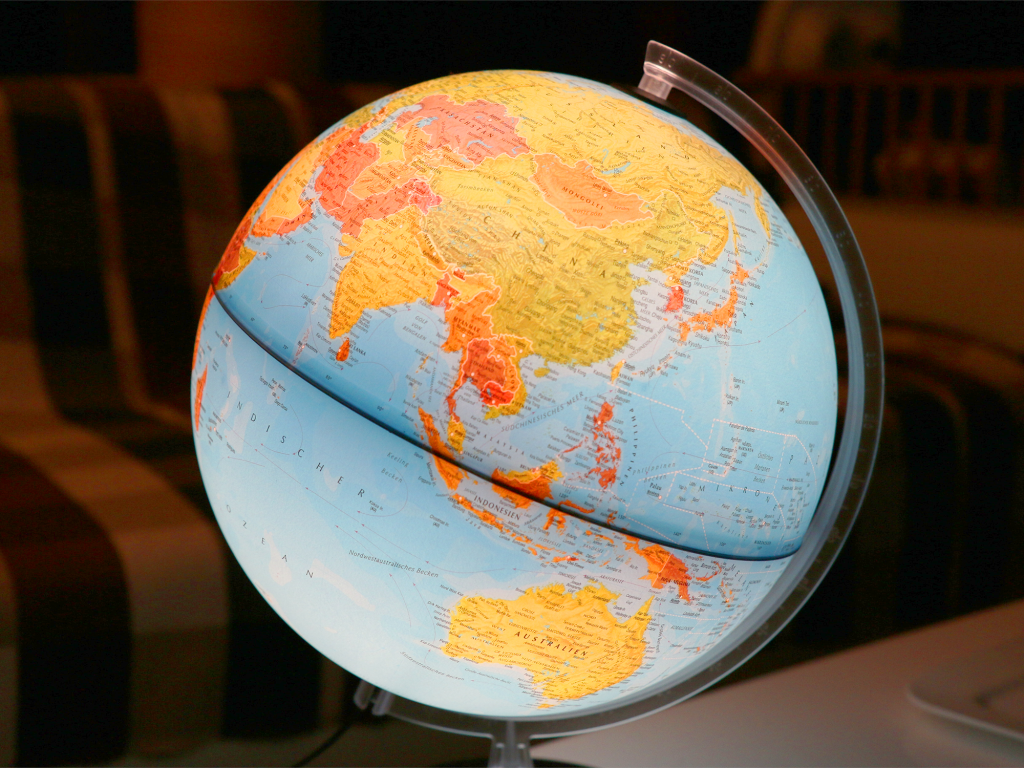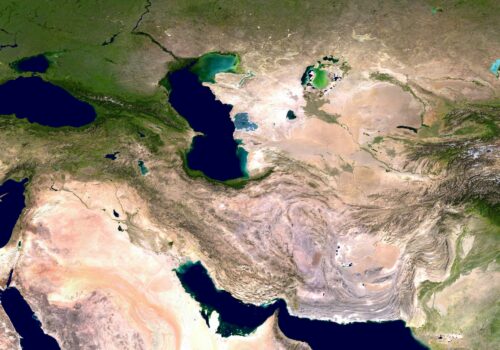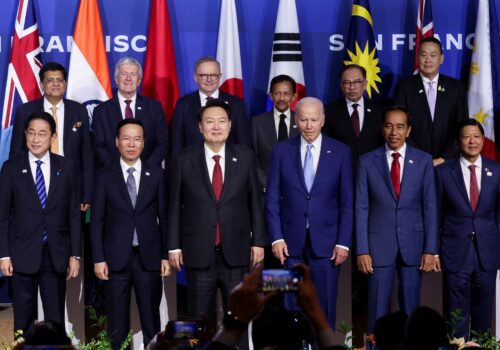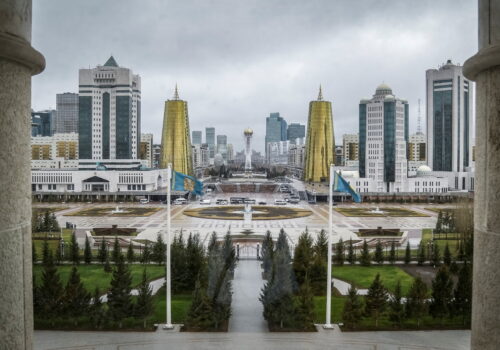The future of US and Japanese engagement with Central Asia
Bottom lines up front
- Russia and China have historically and continue to dominate foreign engagement with Central Asia, often not in the region’s best interest.
- Washington and Tokyo should offer high-quality and sustainable alternative models for foreign economic and diplomatic engagement that highlight Central Asian autonomy and adherence to the rule of law.
- Central Asia can offer the United States and Japan access to vast reserves of critical minerals that would enable diversification of supply chains vital to national security, away from Beijing.
Situated between China and Russia, and with an abundance of vital natural resources, Central Asia is an area of strategic interest for Tokyo and Washington. Beijing and Moscow currently enjoy overwhelming political, economic, and cultural influence, which limits other countries’ ability to constructively shape the region. Some friction has emerged between the two authoritarian powers as post-Soviet dominance over Central Asia erodes and Chinese economic influence takes its place. But Moscow and Beijing have put their differences aside to present a united front against what they see as the larger threat of growing Western influence in the region. The aftermath of Russia’s 2022 invasion of Ukraine is a key example of the utility Central Asia offers: In the face of Western sanctions, Central Asia serves as a loophole through which Russia gains access to Chinese materials to fuel its war effort.
Russia and China will always be present in the region. But Central Asian countries recognize that economic growth will require diversified engagement, and not just with their autocratic neighbors. Tokyo and Washington would be wise not to let this opportunity slip away. They should engage on select areas of mutual benefit rather than force Central Asia to make a binary choice between autocracy or democracy. Japan should leverage its economic prowess through sustainable energy, transportation infrastructure, and human resource development such as student exchanges. The United States should wield its political might to conduct high-profile diplomatic engagements with Central Asia and draw global attention to the region’s increasingly open markets. In turn, Central Asia can offer Tokyo and Washington greater access to its vast reserves of natural resources—particularly of critical minerals, which are essential to both countries’ national security and economic resilience strategies. Japan and the United States can promote regional democracy and freedom by engaging on a diverse set of areas according to their unique strategic interests and by burden sharing with like-minded allies.
Challenges
Central Asia is a landlocked region consisting of five former Soviet republics: Kazakhstan, Kyrgyzstan, Tajikistan, Turkmenistan, and Uzbekistan. Fundamentally, because of geography, economics, history, and linguistics, China and Russia wield more influence in Central Asia than Japan and the United States do. Although each country has its own official language, Russian remains the dominant second language. The region is bordered by Russia to its north and China to its east, while Tokyo and Washington are located 3,319 miles and 6,530 miles away, respectively, from Almaty, the capital of Central Asia’s largest economy. As a result, Central Asia’s geographic and economic gravity tilts heavily in favor of trade with neighboring autocracies.
Central Asia is signaling to the world that it seeks to diversify economic relations, but this is easier said than done. The United States and Japan have limited economic footprints in Central Asia given the region’s distance and relative inaccessibility. To gain access to economies other than China or Russia, Central Asian countries must ship goods overland for long distances or pay exorbitant costs for air freight. They also cannot directly access maritime freights without passing through countries that are unfriendly, unreliable, or both (the likes of Russia, China, Pakistan, Afghanistan, or Iran). For example, Kazakhstan’s primary access to global markets is mediated by Russia’s Novorossiysk Marine Terminal along the Black Sea, from which it ships crude oil.
An alternative is a multi-modal (maritime and overland) route through the Caspian Sea. Following the 2022 Russian invasion of Ukraine, the Trans-Caspian International Transport Route (TITR), also called the Middle Corridor, has expanded rapidly as a vital trade network to deliver resources between Asia and Europe without needing to enter Russia. Despite bypassing Russia, the Middle Corridor still poses the problem of amplifying Chinese trade with, and influence in, Central Asia.
Chinese and Russian dominance, and their subsequent influence on decision-making of Central Asian elites, has limited the region’s autonomy and its ability to improve political freedoms to meet global standards. In 2025, all five Central Asian countries were designated “not free” and scored abysmally on Freedom House’s Freedom in the World index, with Kyrgyzstan at 26, Kazakhstan at 23, Uzbekistan at 12, Tajikistan at 5, and Turkmenistan at 1 on a scale of 100. These scores provide a snapshot of each country based on analysis of its electoral process, political participation, government function, freedom of expression and of belief, organizational rights, rule of law, and individual rights. The Atlantic Council Freedom Index also found Central Asia lacking in its scores. In 2024, Japan and the United States scored 85.9 and 85.1, respectively, on a scale of 100. Central Asia scored significantly lower on the scale, with Kyrgyzstan at 55.2, Kazakhstan at 54.6, Uzbekistan at 52, Tajikistan at 40.8, and Turkmenistan at 24.4. The Freedom Index ranks countries by calculating the average of three subindexes that measure adherence to the rule of law; election process and limits to the leader’s power; and the degree to which economic activity is governed by free and competitive market principles.
It is not at all a priority for Moscow or Beijing to see Central Asian nations become freer; in fact, the region’s lack of freedom serves their own interests. The role Central Asia has played during the war in Ukraine is a prime example. In the wake of Russia’s 2022 invasion, allies including the United States and Japan drew up a list of global items critical to Russian weapons productions—the fifty-item Common High Priority Items List (CHPL)—on which to enforce export restrictions. However, almost immediately after Russia’s invasion, Central Asian imports of CHPL goods spiked dramatically. According to TRM Labs, Kyrgyzstan for example emerged as a crypto hub for the Russian illicit finance ecosystem to evade sanctions and procure technologies with dual-use capabilities from China. These goods were then re-exported to Russia, allowing it to circumvent global sanctions.
Limited Central Asian political freedom also undoubtedly hinders robust economic growth, one of the most important goals for the region. Without transparent and accountable political institutions in place to uphold the rule of law, there is no way for fair contracts and business rights to be protected against corrupt practices and state intervention. In 2024, the Corruption Perceptions Index ranked Central Asia at 35 out of 100 on its perceived level of public-sector corruption on a scale of 0 (highly corrupt) to 100 (very clean). Japanese and US investors seeking to enter Central Asian markets will remain deterred by non-transparent practices and weak protections.
Opportunities
Central Asian context
Having only gained their independence from the Soviet Union in the 1990s, the five Central Asian countries are relatively new players on the global stage. However, a March 2025 agreement among the Central Asian leaders marked the resolution of all territorial disputes and political grievances for the first time since the collapse of the Soviet Union. Setting aside regional disputes in favor of collective economic growth has proved favorable for the region. In April 2025, the World Bank announced that, with a combined 4.7 percent economic growth forecast, Central Asia is expected to remain the fastest-growing region in Eurasia, having quadrupled its combined gross domestic product.
With this newfound potential, Uzbekistan and Kazakhstan to a greater extent and Kyrgyzstan and Tajikistan to a lesser extent, seek diversified foreign engagement to boost economic growth—not just with China and Russia, which dominated foreign direct investment at 23.9 percent and 22.7 percent, respectively, in 2024. Of utmost importance to geopolitics are Central Asia’s stockpiles of rare earth elements. In 2017, the US Geological Survey identified 384 sites containing rare earths and metals across the region—160 in Kazakhstan, eighty-seven in Uzbekistan, seventy-five in Kyrgyzstan, sixty in Tajikistan, and two in Turkmenistan. These deposits present a vital opportunity for Japan and the United States to diversify supply chains away from China while supporting Central Asian growth.
The Central Asia+ (C5+) Dialogue that Japan pioneered in 2004 and C5+1 that the United States launched in 2015 have served as the basis for global engagement with the region and should continue to do so. These frameworks offer the region the flexibility to engage with multiple external partners without being forced into a zero-sum decision between autocratic and democratic systems. It allows all five states to amplify their voices on issues of shared concern while simultaneously being able to pursue bilateral relationships that cater to each country’s national interests.
Japanese strategic advantages
Despite its wealth of natural resources, Central Asia is predominantly reliant on non-renewable oil and gas. As a global leader in sustainable energy, Japan should offer expertise in emission-reducing technologies such as fossil fuel-fired thermal power plants and producing hydrogen and fertilizers from natural gas. One successful example it could replicate is the 2023 Memorandum of Cooperation on the Joint Crediting Mechanism, which included the provision of Japanese technology and loans to support Kazakhstan’s green energy transition. In return, Japan gained access to Kazakh uranium mines, which helps fuel Japan’s nuclear energy sector.
Another area of potential mutual benefit is Japanese investment in developing Central Asian human capital. Japan should offer more scholarships and exchange programs with universities and research institutions for Central Asian citizens, particularly in areas such as economics, management, science, and technology. This, coupled with the opportunity for Central Asians to participate in vocational training programs, can provide Japan a pipeline to address the workforce shortage driven by its aging population.
Relatedly, Japanese expertise can play a crucial role in improving Central Asian transport and logistics industries. Japan can use its collaboration with India to develop the Mumbai-Ahmedabad high speed railway as a model, and can similarly apply the high safety standards, precise technological capabilities, and punctual operations of its Shinkansen bullet train to Central Asia. With decades-long experience operating in 140 countries, the Japan International Cooperation Agency (JICA) is a government agency well-positioned to provide financial assistance to Japanese companies that are eager to tap into Central Asia’s critical infrastructure and development sector.
Central Asia is a vast region with a relatively small population that remains poorly connected. This severely hinders the region’s ability to unlock its full economic and logistical potential. Japanese assistance in developing transportation and logistics networks will not only benefit the region but will also facilitate trade and reduce transportation costs for delivering Central Asian goods into global markets through TITR. Japan seeks to mitigate Russian and Chinese dominance in the region by providing alternative models for trade and governance focused on quality and sustainability. For example, JICA partnered with the World Customs Organization to provide training to Central Asian customs officers to facilitate legitimate trade and intercept smuggling and fraud through enhanced customs risk management.
US strategic advantages
Central Asian countries have made considerable efforts to liberalize their market economies in the more than three decades since the collapse of the Soviet Union, but the US Jackson-Vanik amendment, established in 1974, continues to deny normal trade relations status to four of the five Central Asian countries: Kazakhstan, Tajikistan, Turkmenistan, and Uzbekistan. These countries are required to pay higher export tariffs and cannot access investment or credit guarantees. As Central Asian countries liberalize and meet the threshold for a market economy, they should be rewarded with the lifting of the provision’s trade restrictions. There is already momentum for this, as the US Department of Commerce elevated Kazakhstan to market economy status in March 2002.
Several high-profile meetings have taken place this year, including the first Central Asia-European Union summit and the second China-Central Asia Summit. Washington would be well-suited to conduct a comparable high-level C5+1 summit this year to mark the tenth anniversary of this multilateral forum, Further, Donald Trump becoming the first US president to visit Central Asia would secure strategic interests and demonstrate strength to China and Russia. As the Trump administration takes a transactional approach to global foreign policy, remaining committed to convening the 2025 Business five Central Asian countries plus the United States (B5+1) framework in Bishkek to bring together US and Central Asian private and public-sector leaders would pay dividends for Washington.
Enhancing US presence in Central Asia aligns well with Trump’s second-term reorientation away from the Middle East and Europe and toward the Indo-Pacific. With its convenient placement on China’s western border, Central Asia can strengthen Washington’s position in its technological rivalry with Beijing. Currently, China mines 70 percent of the world’s rare earth elements and has a virtual monopoly on refining and processing. Central Asia’s critical mineral reserves could prove indispensable as Washington seeks to contain Chinese global economic influence. For example, Washington and Astana can build on the momentum of the June 2025 commitment to trade and investment in critical minerals between US Secretary of State Marco Rubio and Kazakh Deputy Prime Minister and Minister of Foreign Affairs Murat Nurtleu to establish a US-Kazakhstan Minerals deal akin to the April 2025 US-Ukraine Minerals deal. A key component of this deal could be US investment in Kazakhstan’s mineral processing plants, which would boost revenue and develop greater economic autonomy for Astana. At the same time, this is more cost-effective for Washington as it can now access strategic minerals directly from the source. This furthers Washington’s bipartisan aim of diversifying US critical mineral supply chains away from its geopolitical competitor, China, as they are the building blocks of virtually all modern military technology, including radar systems and missile guidance systems.
As the strongest military power in the world, Washington has long collaborated with Central Asian republics to address threats posed by extremist groups—including, but not limited to, the Islamic State of Iraq and al-Sham (ISIS) and its Afghan branch. Although the United States has withdrawn its troops from Afghanistan, investing in counterterrorism efforts remains necessary, as regional instability will have far-reaching consequences. The United States should continue to monitor and assist Uzbekistan and Tajikistan, which are engaging with the Taliban and leveraging Central Asia’s negotiating power regarding matters of regional concern.
Conclusion
Russia and China have historically and will undoubtedly continue to play a significant role in Central Asia. However, much of this engagement is not in Central Asia’s best interests. Most notably, Moscow has used Central Asia as a means to evade global sanctions and fuel its war effort against Ukraine. Furthermore, the proximity and overwhelming influence of China and Russia has suppressed Central Asia’s appetite for improving political freedoms and developing economic autonomy. It therefore goes without saying that a number of barriers stand in the way of increased US and Japanese engagement with Central Asia, not least of which is the physical distance between these regions. But now is not the time for Tokyo and Washington to dial down Central Asian engagement. Rather, the opposite is true.
Central Asia, located in a crucial geopolitical location, can offer the United States and Japan strategic access to critical minerals that would enable diversification of vital national security supply chains away from Beijing. In turn, Japan and the United States can leverage their areas of strategic advantage, specifically in development assistance and diplomatic power, to collectively boost Central Asian economic growth. Without forcing a zero-sum decision between democratic and autocratic systems, Washington and Tokyo should highlight the potential areas of mutual benefit, including but not limited to improved rule of law and protections for economic activity, that they can bring to the table when engaging forward-leaning Central Asian countries. Ultimately, Japan and the United States must toe a careful line of steadily increasing regional engagement without drawing too much ire, while also ensuring Central Asian autonomy and decision-making power are preserved.
Acknowledgements
This work on Japanese and US engagement with Central Asia by the Indo-Pacific Security Initiative of the Atlantic Council’s Scowcroft Center for Strategy and Security has been made possible by support from the Embassy of Japan in the United States of America. The Atlantic Council maintains a strict intellectual independence policy, and the analysis and conclusions presented in this issue brief are the author’s alone.
About the author
Related content
Explore the program

The Indo-Pacific Security Initiative (IPSI) informs and shapes the strategies, plans, and policies of the United States and its allies and partners to address the most important rising security challenges in the Indo-Pacific, including China’s growing threat to the international order and North Korea’s destabilizing nuclear weapons advancements. IPSI produces innovative analysis, conducts tabletop exercises, hosts public and private convenings, and engages with US, allied, and partner governments, militaries, media, other key private and public-sector stakeholders, and publics.
Image: Kazakhstan's President Nursultan Nazarbayev (R) and Japan's Prime Minister Shinzo Abe shake hands during their meeting at the Akorda presidential residence in Astana, Kazakhstan, October 27, 2015. REUTERS/Mukhtar Kholdorbekov




